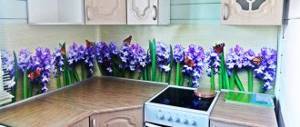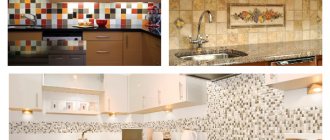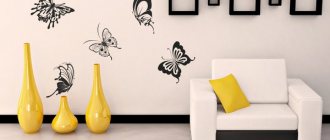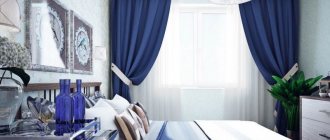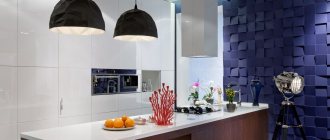What to consider when preparing for class
What paints and base can be used, the size of the workpiece
In the middle group, preschoolers develop the ability to create decorative compositions based on Russian folk ornaments (haze, Filimonov patterns, Gorodets painting). This certainly develops children's aesthetic senses. Based on the sample, they begin to create patterns themselves in the style of the indicated paintings. However, in the classroom it is also necessary to encourage the creative independence of students - they can independently come up with a variety of patterns.
As a basis for such activities, they can use sheets of A4 paper, on which the silhouette of the object that needs to be painted (in this case, an apron) is drawn. The second option is more interesting for children - the teacher offers them already cut out apron templates that need to be decorated. Note that the templates can be pre-tinted by the teacher, or children are asked to first color them and then decorate them.
It is best to use gouache as a material for painting - in this case, the ornaments are bright and rich. You can also draw a decorative composition with watercolors and colored pencils.
Drawing techniques and techniques
Decorative drawing in the middle group is designed to develop a sense of composition ; in this respect, it is similar to applique (pasting ready-made forms in a certain order). First of all, preschoolers learn to draw straight lines, and then apply dots or strokes between them in a certain order. Elements can alternate in color and size.
The easiest technique is a smear : it does not require too precise movements of the brush from the child and is obtained by lightly applying it to the paper. For this reason, strokes are introduced into the composition before the dots.
The dot is a more difficult technique for students in the middle group. The brush is already held vertically, and the child must already have fairly developed coordination of hand movements in order to lightly touch the paper with the tip of the brush.
An even more complex compositional technique is alternation , based on a combination of several forms. In the middle group it begins with two elements that alternate in shape or color. Then the program material becomes more complex, and new patterns are introduced - circles and rings (which the children mastered in the younger group). In decorative drawing, circles and dots are usually small in size; they are not associated with the image of the object - this poses some difficulty for a 4-5 year old child.
As for the lines, they can be not only straight, but also wavy. The points can be placed between the waves. Lines can also vary in thickness and color.
The child can come up with his own ornament , including arcs, flowers, leaves, which are done with both the entire brush and the tip of the pile.
Pupils in the middle group must learn to symmetrically place the pattern on the proposed form (in this case, an apron). In addition, during the work, the child must use the entire paper blank - decorate not only the bottom of the apron, but also its smaller upper part, the straps.
Additional types of visual activities (modeling, applique)
Decorative drawing opens up great opportunities for the use of additional activities - modeling and appliqué . So, you can include elements of plasticine painting into the composition - dots, arcs. As for the applique, you can use it to create a very original craft - by gluing a pocket and ribbon ties to a painted apron. You can also get an unusual job if you glue some ready-made shapes - circles or lines. The pasted circle can be transformed into a flower by adding petals to it.
Is it possible to individualize tasks according to design and level of difficulty?
Some students in the middle group already show special abilities for artistic creativity. Such children, as a rule, quickly complete the task, and in order to interest them even more, the teacher may well give them additional individual tasks, for example, additionally decorating the composition with plasticine or gluing paper flounces to the bottom of the apron (the teacher will help cut them out).
↑ Choosing fabric for an apron
For the simplest detail of a modern woman's kitchen suit, choosing the right fabric is not so easy; several important factors need to be taken into account.
- The kitchen is a place where the risk of getting clothes dirty increases many times over, and it is the apron that should protect it from possible stains, taking the blow on itself. The apron will have to be washed quite often, and stains on it can be difficult to remove, so it is desirable that the chosen material is durable and easy to clean, and can also withstand the effects of aggressive cleaning agents.
- The choice of color for an apron is determined by personal preferences, and there are no strict rules here. The housewife can choose the color of the fabric taking into account the overall style of the kitchen, or she can choose colors that, on the contrary, will contrast with the color scheme of the interior.
- Stains on a plain fabric are usually more noticeable than on a multi-colored one, therefore, even a dirtier apron made of colored fabric will look neater than a plain one, but this does not mean that you can wash it less often.
- Plain fabrics of dark colors will hide stains of dirt, but will make you so bored that kitchen work will turn into an unpleasant chore, and to prevent this from happening, it is not recommended to choose them only for practical reasons.
- The black color of an apron is ideal for dirty work in the kitchen, but it has a depressing effect on the people’s psyche. The white contrasting details of this apron make it not only attractive, but also flirty.
- Psychologists have determined that colors affect people differently. For example, the color red and its shades stimulate the appetite and lift the mood, which is why plain red, red with white checkered or polka dot aprons have been popular among housewives for many years. In addition, red suits many women.
All these rules apply mainly to those aprons that will play the role of an important decorative element in the kitchen. If we are talking about a means of protecting the housewife’s clothes, then you can simply take an old dress that no one wears anymore, but it would be a pity to throw it away. A good option could be an apron made from jeans that have already served their purpose.
Fantasy and the desire to be unique suggest original ideas for using old denim items. Guests will definitely pay attention to such workwear.
At what stage is the topic of apron decoration studied?
The topic “Decorating an Apron” is offered to middle school preschoolers at the beginning of the school year (around October). This topic is closely related to the study of the topic “Clothing” (as part of classes on familiarization with the outside world) and with acquaintance with Russian folk art (haze, Filimonov patterns, Gorodets painting). By the way, subsequently, in the middle group, children are also asked to decorate a sweater and dress for a doll (these themes solve similar problems).
It is also good to connect this topic with the history of Russian national costume , thereby giving the lesson a patriotic focus. Before the drawing process, children get acquainted with new concepts, learn the names of traditional Russian clothing elements (poneva, kosovorotka, etc.). The teacher briefly explains to the preschoolers the symbolism of colors and geometric shapes on the costume.
Interest in folk traditions, in particular, in decorative and applied arts, is also fostered by the activity “Apron for the Dymkovo young lady.” Pupils consolidate knowledge of the basic elements of the Dymkovo pattern, its color palette (bright rich tones).
Let us note that in the middle group, in front of the children’s eyes there should always be a sample drawing made by the teacher. On its basis, children become familiar with the principle of constructing an ornament and the elements that make it up. The child must understand that the shape of an object determines the nature of the pattern decorating it - this is also where the awareness of the connection between form and content comes from.
↑ Original ideas for the design of kitchen aprons
This apron only at first glance seems complicated; in fact, making it will not take much more time than sewing ordinary kitchen workwear
By making an apron from an old denim skirt, you can make your task easier - after all, the pockets and decorative stitching on the belt are already ready
This model is not difficult even for the most inexperienced seamstress, but well-chosen colors and contrasting pockets will delight the owner of the apron
The most common apron model will appear in a new light with the right choice of fabric colors and accessories
For her beloved assistant, a mother can come up with a very unusual design of kitchen work clothes
Source
Summary of a drawing lesson in the middle group: decorating an apron
| Author's full name | Title of the abstract |
| Titarenko A.A. | “Decorating an apron” (decorative drawing) Educational objectives : learn to make a simple pattern from various elements (dots, lines, circles), consolidate the technique of dipping, develop a sense of composition, rhythm, learn to independently choose the color for the pattern. Developmental tasks : develop color perception, imagination, activate the vocabulary of preschoolers (pattern, pattern element), develop spatial imagination (reinforce the concepts of “left”, “right”, “above”, “under”). Educational objectives : to cultivate independence in creative activities. Integration of educational areas : “Artistic creativity”, “Cognition”, “Communication”, “Socialization”, “Health”. Demonstration material: teddy bear toy, samples of decorated aprons. Handouts: cut out silhouettes of aprons (for each child), gouache, brushes, stands for brushes, jars for water. Preliminary work: examining beautiful products: scarves, aprons, shawls, etc. Progress A surprise moment - the appearance of Mishutka. He is sad because he is expecting guests tomorrow and wants to prepare a treat for them, but he is very afraid of getting his beautiful fur coat dirty. This is where motivation arises - Mishutka needs help - to make a beautiful apron for him. Of course, children are enthusiastically ready to fulfill the character’s request. Looking at examples of decorated aprons on the board. Discussion of different pattern options. You can place stripes at the bottom, and design the leaves in the form of simple strokes. Flowers are depicted in a similar way - a circle to which petal strokes are added. During such a conversation, children consolidate orientation in space: the leaves are located on the apron to the left and right, and between them there is a flower. The teacher tests the children's knowledge of colors and geometric shapes. Before the actual productive activity, physical education or finger gymnastics is carried out, which in its meaning should be linked to the topic of the lesson. For example, “Our delicate flowers” |
| Medvedeva S.N. | “The history of the Russian costume “Decorate the doll’s apron” This decorative drawing activity has a patriotic focus - it is connected with the history of Russian folk costume (in this case, its Tambov version). The symbolism of the ornament is explained to the children, and their vocabulary is expanded by introducing them to new concepts (poneva, kosovorotka, ports, shirt, kokoshnik). It is good to include musical accompaniment in such activities - Russian folk songs and melodies, show corresponding illustrations by Russian artists, slides depicting Russian costumes. At the beginning of the lesson, the poem “What we call Motherland…” is read. Children and their teacher discuss its contents, repeat the name of our country and the city in which they live. The question is raised: who are our ancestors? what were they wearing? Where can you see these clothes now (in museums or fairy tales)? The teacher tells the children about the symbolism of color and geometric shapes in clothing patterns: a wavy line is water, a circle is the sun, blue is joy, red is prosperity, yellow is warmth. As a motivating moment, the Matryona doll appears in a Russian national costume and asks to make her a beautiful apron, which the children gladly agree to do. Let us note that physical education is also carried out in the Russian folk spirit - in the form of the round dance game “Zainka”. |
| Meshcheryakova I.P. | “Apron for a magpie” The motivation for the activity is interesting. A toy magpie flies to the children. The poem by Ivan Demyanov “Magpie Apron” is played. The teacher and the children discuss why the magpie's apron on its chest became black (according to the plot of the poem, it became so because she forgot to take it off when she lit the stove). To help the magpie and make it happy, kids are invited to give the bird new painted aprons. The samples on the board are examined. The teacher explains the sequence of work, calling one stronger child to show. The physical education lesson is also related to the theme of the lesson “A magpie flew to us...”. At the end of the lesson, the magpie promises to take the aprons with him when they are dry and give them to his girlfriends. |
| Gryaznova O.I. | “Decorating aprons with Dymkovo painting” (decorative drawing) The objective of the lesson is to consolidate the elements of Dymkovo painting (circles, rings, dots, dashes). Children are invited to paint the silhouette of the apron of the Dymkovo young lady. In this case, the bright, rich colors characteristic of Haze are used (red and yellow, blue and green). Preliminary work for such an activity includes looking at the album “Dymka”, getting acquainted with the exhibition of Dymkovo clay toys, among which there must be a figurine of a young lady. As a surprise, the Dymkovo young lady comes dancing to the children accompanied by a cheerful musical composition. She asks the children to guess where she is from and talks with them about folk craftsmen. The young lady demonstrates drawing circles, dots, rings on the board and invites the guys to paint an elegant apron for her and her friends. To the accompaniment of Russian folk music, the children and the young lady dance the round dance “Sudarushka”, and then begin to work independently. By the way, an interesting moment - the young lady tells them that she can do miracles, pronounces magic words and turns children into folk craftsmen |
↑ Ideas from old magazines or “Rabotnitsa” also wrote about this
If your own ideas on how to sew an apron do not seem so original, you can look for ready-made recommendations in old books on home economics or the Internet. For example, the idea of sewing an apron from four large handkerchiefs or bandanas is easy to implement, and the variety of colors of the source material will give you the opportunity to experiment with color combinations.
One of the simplest and cheapest options is to sew an apron from large handkerchiefs or small bandanas
Such an unusual silhouette should be obtained if we take the above diagram as a basis.
In those distant times, when careful housekeeping and economy were considered positive qualities of a housewife, when the passion for consumption was not yet so strong, many things found new uses and could serve usefully for some time. For example, after simple manipulations, a men's shirt can turn into an apron for the kitchen. Such ideas for using old items can be found in old magazines.
Did your husband say he won't wear this shirt again? Great! Let's make an apron out of it, let it also serve in the kitchen
Another option for turning an old shirt into a kitchen apron from an old magazine
In old publications you can find many aprons in a retro style, but they can hardly be called old-fashioned - such silhouettes are still relevant today
Samples and step-by-step description of the work procedure
A simple apron template (photo 1) is decorated only with straight lines. All stripes are the same width. The main task of such artistic activity is to teach preschoolers to alternate elements by color in a certain order.
The apron in photo 2 has a more intricate silhouette - decorated with flounces at the bottom. Pupils of the middle group were asked to decorate it with a Dymkovo pattern based on the image of circles, dots, rings and the intersection of straight lines. The color scheme of the composition corresponds to Dymkovo traditions. Similar children's works are presented at the exhibition in photo 3.
The drawing lesson “Apron for a doll” (photo 4) includes elements of mathematical concepts: decorating the blank with circles and crosses, while drawing, the children of the middle group consolidated the spatial concepts of “left”, “right”, “above”, “below”, "in the middle".
Photo 5 shows aprons belonging to the Tatar folk costume. This lesson takes place within the framework of the project: in addition to the apron, the guys painted boots and dresses with a vest.
